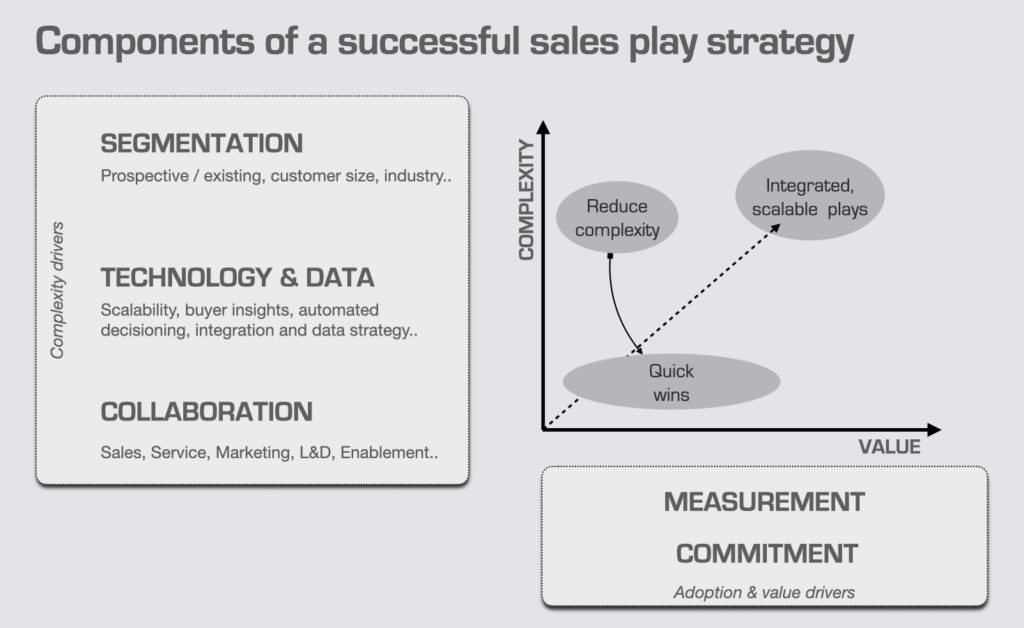Crafting Sales Plays for Digital Sellers
2.8K Views | 12 Min Read
The concept of a sales play is not new. In fact, sales plays have existed as a way of guiding sellers through how to execute specific sales scenarios far longer than many contemporary sales automation platforms. But as sales technology has grown and improved, so has the ability to effectively deliver and measure the impact of sales plays. The following breaks down how sales plays can be effectively created in a digital world to enable sellers for success.
What is a Sales Play?
Internet searches return a vast array of sales play definitions, many of these related to sales technology vendors. While sales plays, and measurements of their effectiveness, benefit significantly from technology, technology is simply an enabler to guide sellers through a sales motion or sales cadence. Tactically, sales plays represent a defined set of interactions, executed within a prescribed timeframe. The major attributes of how to execute a sales play, modified by customer segment, can include:
- Timeline: a discrete time frame against which the sales play is executed. After a time, there is marginal value in continuing to pursue a customer or prospect, representing an opportunity cost. Audience size (corporate, large/mid-market, SMB, etc.) influences this attribute and organization-specific best practices will emerge as sales play insights unfold.
- Scheduling: the best time of day to interact with the audience. This will differ based on the industry of the engaged audience. For example, there are better times in the day when attempting to engage with a decision-maker at a restaurant as opposed to a professional services firm.
- Frequency: the number and spacing of interaction points through the sales play. High-volume campaigns, which are typical in SMB, will have fewer interaction points, spaced tightly together. Meanwhile, low-volume campaigns such as those in enterprise will often have more interactions, spaced out over a longer period of time.
- Channels: the combination of communication channels and the tactics influencing when and how a channel is triggered for audience engagement.
- Content: the key messages conveyed to the audience. This is a complex attribute, as content is influenced by audience industry, size, purchase readiness, and media receptivity (audio, video, presentation, etc).
What are the Components of a Sales Play Strategy?
At the level of the sales play, strategy can be defined as the choice of tactics that enable superior sales play performance. The choice of tactics starts as experimental, with each motion refined over time. At the portfolio level, strategy can be defined as the choice across sales plays, based on the value that each play journey will deliver. Both levels of strategy need to anchor back to the prevailing organizational strategy, ensuring that their value is fully aligned.
The following framework discusses the choice of sales play at the portfolio level based on two principle facets: complexity versus value. Complexity can be decomposed to the following three dimensions: segmentation, technology, and collaboration. Foundational to developing a successful sales play strategy are two further dimensions: commitment and measurement. Both are vital to reinforcing value and driving adoption.

Segmentation
This is central, and it is an important first step. Factoring more firmographic and technographic details into a segmentation methodology will reduce some of the strategic complexity, allowing plays to become specific, directive, and consistent. However, this can also increase some of the technical integration complexities.
The primary level of segmentation may seem basic, but it is essential to structuring the appropriate approach: are you addressing prospective customers or existing customers, inbound lead flow or outbound sales activity, new business growth or customer churn reduction? Each segment requires a different set of engagement tactics and therefore a unique sales play design.
Segmentation based on customer size can have a huge influence on sales play practices. There is a significant difference between Account Based Engagement (ABE) approaches targeted at strategic accounts where sellers typically have more autonomy over the sales motion and where each interaction will be highly varied, versus demand-driven approaches targeted at SMB accounts, where the motion is much more directive.
More granular approaches to segmentation enable deeper personalization. The prevailing example is industry or vertical. Executed well, this improves the customer experience, though the trade-off is that the seller may need more specialized knowledge at the level of granular abstraction.
Technology and Data
Integration through the sales, marketing, and sales enablement tech stacks is a critical ingredient, ensuring the delivery of accurate information that is necessary for both play tactics and post-play evaluation. This enables the sales play to be executed effectively while ensuring scalability, consistency, and repeatability, ultimately leading to increased productivity. For example, technology and data can be used to provide buyer insights that link back to the ideal customer profile and provide the seller with the rationale (the “why”) behind a potentially attractive customer interaction. Further inclusion of buyer intent can be hugely powerful.
Similarly, embedding data science and machine learning into the technology stack can further automate decisions behind which customer, which objective, and which play. Of course, this must be managed ethically and appropriately, within the guidelines of data privacy and security mandates, such as GDPR. A key pain point for analytics teams is the need to stitch together, cleanse, and process data from multiple sources to provide digital sales play performance insights. Linking the sales tech stack roadmap into the wider data and IT strategy is complex work, though it can generate a real competitive advantage.
Collaboration
Effective connections between marketing, sales, service, learning and development, and sales enablement are essential to the successful design and implementation of sales plays. Having personally designed sales cadences, all participants need to be invested and “in the room” to design journey interaction points and develop specific content messaging.
Measurement
Sales plays need to be measured and analyzed so that the value hypotheses can be validated, and effectiveness of interaction points and channels assessed. Measurement provides the sales enablement function with return on investment insights and can be funneled to the sales organization to reinforce the need for adoption, creating a “win-win” for all parties.
Commitment
Designing and delivering sales plays is a process of change management, and commitment is necessary across relevant stakeholders and champions. Without commitment, adoption may decelerate.
What are Common Challenges to Creating Sales Plays?
Creating sales plays in a digital environment, even when executed within a framework, is not without its challenges. Keeping some of these common challenges in mind from the start of the process can help teams avoid or mitigate them as they arise.
- Hubris is a major challenge. The desire and urgency to deliver genuine change can be strong, but an organization’s ability to quickly build the investment capacity and take experimental steps with both technology and process can take much longer. Hubris can be a competitive differentiator. Taking advantage of a rival’s flat-footed go-to-market approach enables superior performance. Equally, the potential number of sales plays can be overwhelming. To mitigate, start small and simple. Focus on the quick wins and build the organizational “sales play muscle” over time.
- Gaining buy-in from all related stakeholders is the passport to success, and a key obstacle to overcome. Even with strongly aligned objectives, agendas diverge across functions and securing bandwidth to develop a sales play is a matter of prioritization and negotiation. Keep the approach simple and deliberately reduce complexity. Sophistication can be added over time.
- The speed of technology delivery and integration can also seem challenging with a growing array of sales technologies that requires a growing understanding of the vendor landscape. Within highly regulated industries such as financial services and healthcare, compliance oversight requires a more measured approach to installing SaaS-based sales and marketing platforms, especially where these touch highly sensitive, personally identifiable data.
How can Success be Measured?
Finally, implementing a sales play strategy requires careful measurement against defined key performance indicators (KPIs) in order to monitor success and make adjustments as needed. To identify applicable KPIs, a full-funnel approach can be applied. In doing so, leverage relationships with sales leaders to identify, align, and define KPIs that resonate with their business needs. In turn, the measurement and sharing of success can continue to reinforce the benefit of sales enablement to the sales function.
Focusing specifically on the sales play activity, the following metrics across different stages can be useful:
- Top-of-funnel: For SDRs and BDRs seeking to shift the engagement model from one-to-many to one-to-one, metrics can include:
- Marketing collateral and buyer engagement results
- Engagement cadence, such as which channels and frequency of communications worked best
- Conversation intelligence results
- Meetings generated
- Sales Qualified Leads (SQLs)
- Middle-of-funnel: At the heart of the sales play are middle-of-funnel activities, as they describe the one-to-one connections with the audience. These types of metrics can include:
- Effectiveness of marketing content, channels, and cadence design
- Rep productivity indicators, including meetings generated, pipeline velocity (speed of deal through sales process), and pipeline balance (percentage deals in early, mid, and late sales stages)
- Bottom-of-funnel: These represent the final set of pre-revenue indicators. Consider the following metrics:
- Sales conversion results
- Win/loss ratios
- Win/loss drivers
Each sales play can be defined by five attributes that detail the necessary content and interaction pattern. Within these five dimensions, sales plays can range in complexity. While complexity often correlates with value, there is a benefit in identifying plays that are unnecessarily complex and can be simplified in line with value creation.
To better enable sellers to effectively execute a sales strategy in the digital world, sales plays can be designed with timeline, scheduling, frequency, channels, and content in mind. By then including segmentation, technology, collaboration, measurement, and commitment as part of the sales play strategy, practitioners can overcome some of the common challenges to deploying sales plays. Finally, careful measurement against KPIs across the entire sales funnel can help ensure plays are delivering their intended impact.















